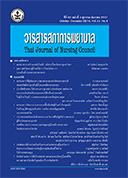Effects of Nursing Case Management Programme on Care Outcomes in Patients with Multiple Trauma
Keywords:
nursing case management, multiple trauma, care outcomesAbstract
Objective: To examine effects of a nursing case management program (NCMP) on
patients’ length of hospitalisation, their ability to perform activities of daily living (ADLs),
and their caregivers’ ability to perform ADLs and to prevent complications in the patients.
Design: Two-group only posttest experimental design
Methodology: The participants were patients with multiple traumatic injuries admitted
in a trauma ward, and their caregivers, forming a total of 40. Twenty (20 patient-caregiver
pairs) were assigned to a control group and the other 20 (20 patient-caregiver pairs) to an
experimental group. The experimental group received the NCMP for 14 days, during which
the control group was given standard care. The data-collecting instruments consisted of (1)
the Patient’s Daily Living Activities Questionnaire; (2) the Length of Hospitalisation
Record; and (3) the Caregiver’s ADL Ability and Complication Prevention Ability
Questionnaire. The data were analysed using descriptive statistics, independent t-test, and
Mann-Whitney U-test.
Results: The experimental group displayed signifcantly higher mean score on the
patients' ADLs, the caregivers' capability in performing ADLs and preventing complications
in the patients than did in the control group. The experimental group was also found to spend
signifcantly fewer days of hospitalization than did in the control group.
Recommendations: It is recommended that nurses implement this NCMP in patients
with multiple traumatic injuries as a means of reducing their length of hospitalisation,
enhancing the patients’ and their caregivers’ ability to perform activities of daily living, and
enabling the caregivers to prevent the patients from developing complications.
Downloads
References
1.Butcher NE, Balogh ZJ. Update on the defnition of polytrauma. EJTES 2014; 40(2): 107–11.
2. National trauma. Trauma statistics. [serial online] 2014 [cited 2015 April 12]. Available from: URL: https://www.nationaltraumain stitute.org home/ trauma statistics.html.
3. Bureau of highway safety. Highway incidence. Bangkok:Departmentofhighways;2016.(inThai).
4. Sindhu S, Wongrod P. Case management for patients with diabetes and hypertension. Bangkok: Watana printing; 2013. (in Thai).
5.Whitaker CE. Standards of practice for case management. Case Manager 2010; 12(2): 1-30.
6.Nuktesh A. Effects of case management program on self-care capabilities of hospitalized type-2 diabetic patients.[Master of Nursing Science Thesis].Songkhla: Prince of Songkla University; 2012. (in Thai).
7. Chow SKY, Wong FKY. A randomized controlled trial of a nurse-led case management programme
for hospital-discharged older adults with comorbidities. JAN 2014; 70(10): 2257-71.
8.Phochan S.Development of a case management system for patients with ST-elevated myocardial infarction in KhonKaen Hospital. Journal of Nurses’ Association of Thailand, North-Eastern Division 2011; 29(1): 22-30. (in Thai).45
9. Imsukk.EffectsofaMultidisciplinarydevelopmental care model in patients with stroke at Chao PhyaAbhaibhubejhr Hospital. Journal of Nurses’ Association of Thailand, North-Eastern Division 2011; 29(3): 15-24.(in Thai).
10.Chantarasukri P, Pheungbunhan K, Jiranapatthip H. Case management in patients with breast cancer admitted in Uttaradit Hospital.Journal of Nursing Division 2010; 37(1): 85-98.(in Thai)
11.Sen A, Xiao Y, Lee SA, Hu P, Dutton RP, Haan J, et al. Daily multidisciplinary discharge rounds in a trauma center: a little time, well spent . J Trauma 2009; 66(3): 880–7.
12.Ratanalert S. Hospital accreditation in caring for patients with traumatic brain injury: Experiences at Songklanagarind Hospital. Neurological Surgery 2017; 8(1): 5-10. (in Thai).
13.Cohen J. Statistical power analysis for the behavioral sciences. 2nd ed. New Jersey: Lawrence Erlbaum Associates; 1988. p. 54-55.
14.Finkelman AW. Case management for nurses. Boston: Pearson; 2011.
15.Prasat Neurologic Institute. Clinical practice guideline for stroke rehabilitation. Bangkok: Department of Thai Medicine. 2007. (in Thai).
16.Suwanno J. Primary caregivers’ capabilities for providing quality of care to hospitalized stroke patients during the pre-discharge transitional period. The Thai Journal of Nursing Council. 2003; 18(3):1-21. (in Thai)
17.Ratanasila R, Amnatseusat K, Chansirikanjana S, Klunklin S, Keidmongkon P. Effect of case management program for older adults with uncontrolled diabetes mellitus. Journal of Public Health Nursing. 2015; 29(1): 67-79. (in Thai)
18.Songwathana P, Sae-Sia W, Kritrungrote L, Manoonya B. Development of a trauma-based continuing care model for enhancing care outcomes in social unrest area: A case study. Journal of Nursing and Care. 2014; 3(5): 1-8. (in Thai)
19.Phuengbunhan K, Pamosinlapathum T, Mechan L. Developing a model of caring for the critical multiple traumapatientsinUttaraditHospital.Boromarajonani College of Nursing, Uttaradit Journal. 2014; 6(1):24-37. (in Thai)
20.Powell SK, Tahan HA. Case management a practical guide for education and practice 3rd ed. Philadelphia: Wolters Kluwer/Lippincott Williams & Wilkins;2010.
21.Baker SP, O ’ Neill B, Haddon W, long WB. The injury severity score: A method for describing patients with multiple injury and evaluating emergency care. J Trauma. 1974; 14(3): 187-96.
22.Jansugri P, Pungbunhan G, Jiranantipat H. Development case management program with breast cancer patients in Uttaradit Hospital. Journal of Nursing Division. 2010; 37(1): 85-98. (in Thai)








